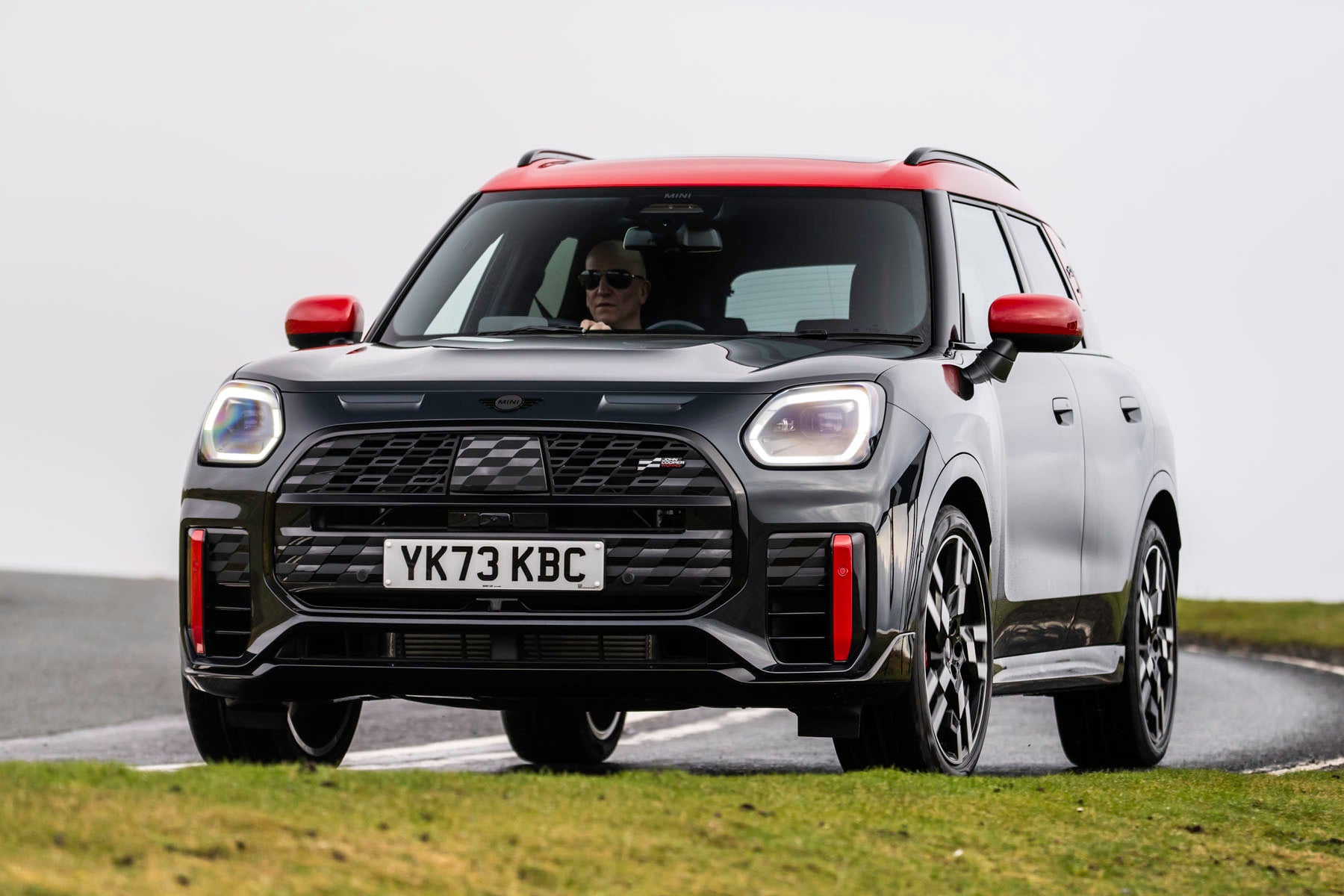MINI Countryman Review 2025: Price, specs & boot space
Written by Ivan Aistrop
Quick overview
Pros
- Impactful styling
- Massive interior space
- Well equipped
Cons
- Cabin quality could be better
- Many rivals ride more comfortably
- Infotainment not the easiest to use
Verdict: Is the MINI Countryman a good car?
"The MINI Countryman has a lot going for it in terms of style, tech, and most notably, practicality: the cabin is absolutely huge. It’s perhaps not the high-quality product that many will be expecting, and the driving experience is capable rather than exceptional, but there’s no arguing with its style."
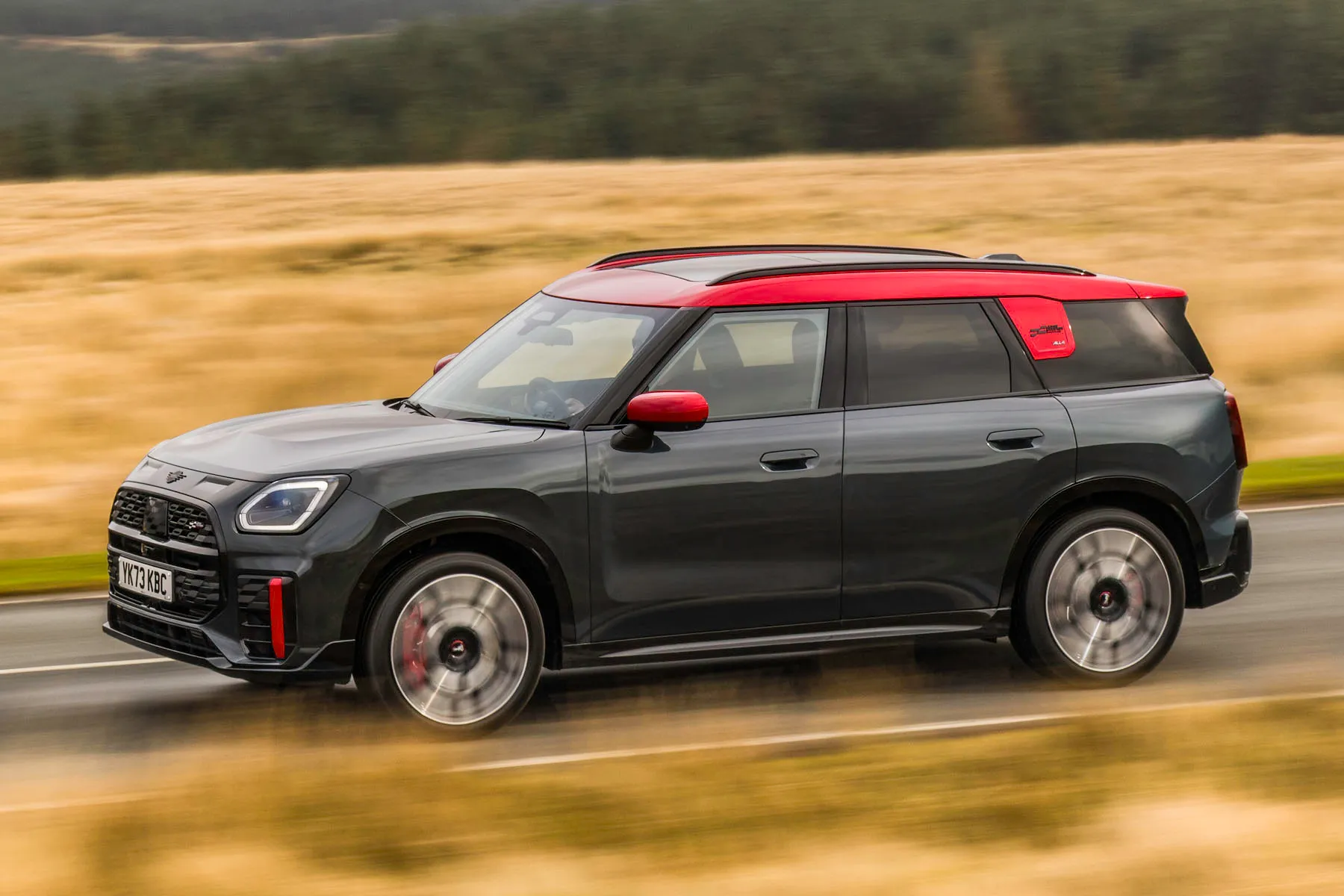
The previous MINI Countryman was the biggest and most practical of the firm’s models, leading some nay-sayers to criticise it - somewhat unfairly, we think - for not being a ‘proper’ MINI. Well, those nay-sayers are likely to be utterly appalled by the new version, because it’s bigger than ever, and by quite some distance. All in all, it’s 13cm longer than the car it replaces, and 6cm taller. Is bigger better? Find out in our MINI Countryman review.
If, however, you’re not one of the nay-sayers, and you simply want a car that’s roomy and practical for the family, then the increase in size should be music to your ears. There’s absolutely masses of space inside the Countryman, and there are several clever touches to make it even more versatile.
What’s more, the cabin is also very big on style, not to mention luxury kit and ground-breaking infotainment technology. The circular central touchscreen is an industry-first, and it looks great, although actually using it can be a little bit bamboozling. The quality of the interior materials might not be quite up to the standards that existing MINI customers will expect, either.
Of course, the MINI brand built itself not only on style and character, but also on driving fun. The Countryman has always been a bit too big, tall and heavy to deliver the true seat-of-the-pants thrills delivered by other MINI models, but it is nevertheless a lively thing to drive, with punchy petrol engines and neat handling, although the latter does come at the expense of a firm ride on some versions. You can also have it as the MINI Countryman Electric, but we’ve reviewed that model separately.
As you’d expect from a premium brand like MINI, prices aren’t cheap, but neither are they ludicrous compared with the competition in the premium compact SUV market. If you’re considering such a car, and your priorities are practicality, style and character, then you could certainly do a lot worse.
Looking for a used car for sale? We've got 100s of MINI Approved Used Cars for Sale for you to choose from, including a wide range of MINI Countrymans for sale.
Is the MINI Countryman right for you?
If you need a family car with lots of interior space, but you also want something that’s brimming with style, character and cheerfulness, not to mention cutting-edge infotainment technology, then the MINI Countryman could be a very good bet indeed.
Do be aware that the infotainment tech can be quite bamboozling to use, and that the interior quality may not be up to the standard that many existing MINI customers would expect, but if that doesn’t bother you, then you’ll probably love it.
What’s the best MINI Countryman model/engine to choose?
We think that most buyers will be more than happy with the entry-level engine choice, the Countryman C, because it’ll have enough performance, refinement and fuel economy to keep the vast majority of drivers satisfied.
On the trim front, all versions are pretty well equipped, but even so, we’d still recommend spending the extra it costs to upgrade to Sport trim. It doesn’t offer much more in the way of luxury equipment, but it looks better, and importantly, the upgrade earns you an adaptive suspension system that makes the Countryman a good bit more comfortable to drive.
What other cars are similar to the MINI Countryman?
As a premium SUV, there are several other models you might be considering alongside the MINI Countryman. These include the likes of the Audi Q2 and bigger Q3, while the Mercedes-Benz GLA is also likely to be on your radar. More German competition comes from the MINI’s own backyard, in the form of the X1 and X2 SUVs offered by parent company BMW. The Volvo XC40 and Lexus UX might also be considered as rivals, alongside the Alfa Romeo Tonale.
Comfort and design: MINI Countryman interior
"The latest MINI Countryman delivers a large, spacious and practical cabin that looks the business and is packed with technology, although those expecting top-notch quality and usability might be rather underwhelmed."
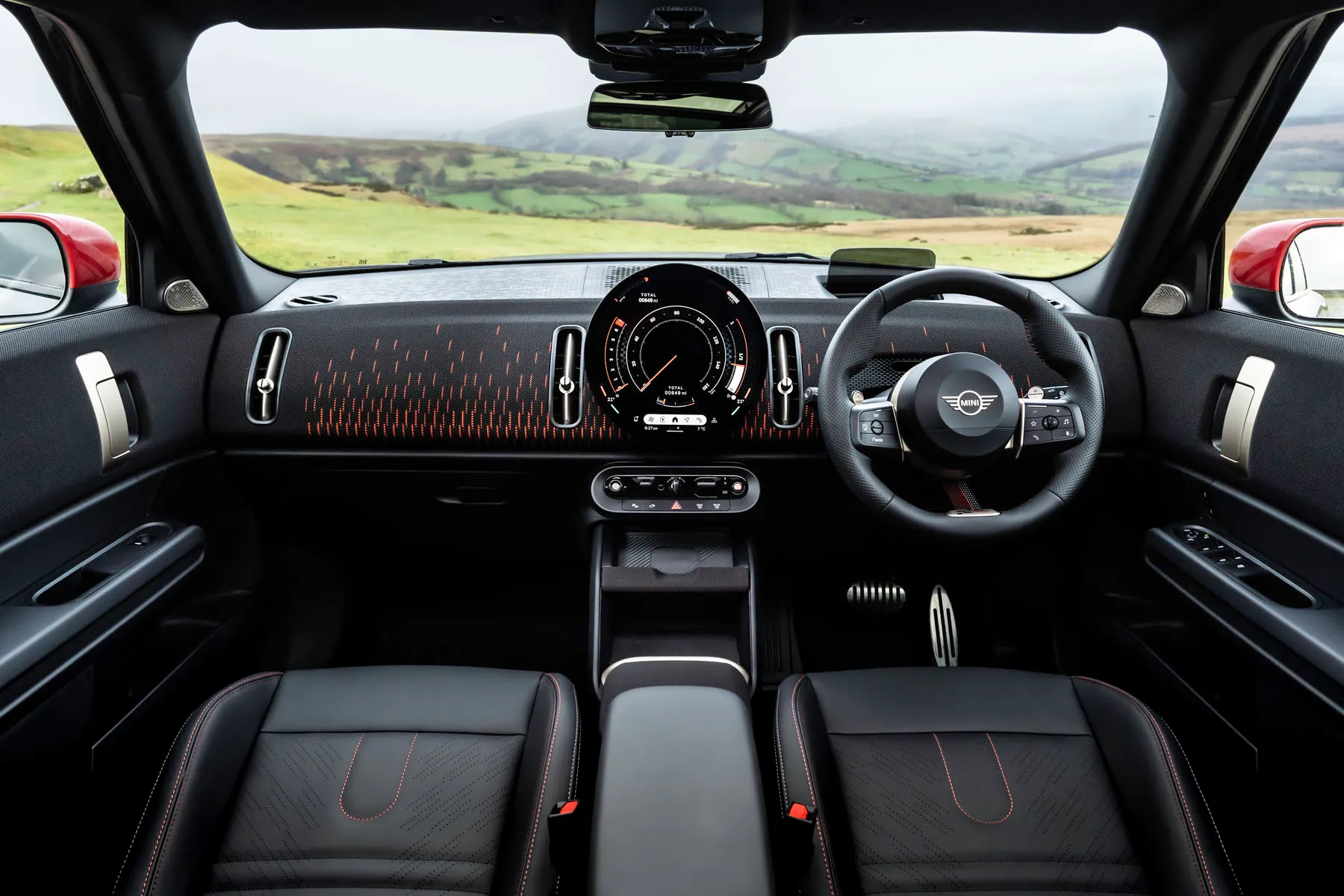
MINI has always been seen as a stylish brand, and the firm’s latest round of products, kicked off by the Countryman, takes that to new levels. Many of the retro styling cues remain, but these are given a modern twist. For instance, the big circular central speedo on MINI models of old is replaced by an industry-first circular touchscreen infotainment system, and as is the fashion these days, the amount of physical switchgear has been pared right back for a more modern, minimalist aesthetic. We’ll touch upon what effect this has on usability a little later, but there’s no denying the interior has a very swish appearance.
The high driving position has lots of adjustment, allowing drivers of all shapes and sizes to get comfortable, and it also helps towards an impressive level of all-round visibility. The rear window is a little shallow, perhaps, but it’s flanked by large rear quarterlight windows that improve your over-the-shoulder view.
Quality and finish
As we’ve just examined, the interior of the Countryman is effortlessly stylish and modern-looking. However, while it looks great at first glance, further inspection reveals that MINI may be using this flamboyant styling to distract from some rather iffy cabin plastics.
For instance, your eyes are immediately drawn to all the glitzy bits: these include the shiny circular touchscreen (more on this in a moment), the stitched leather steering wheel, and the coarse-mesh fabric covering the dashboard and door tops. However, look between the glitzy bits, and you’ll find materials that are a lot less impressive: most are hard, scratchy and rather unappealing. The very top of the dashboard and the lower parts of the doors are arguably the worst offenders. It feels rather too much like cost-cutting in our eyes, and that’s simply not what you expect in a premium product like a MINI.
Infotainment: Touchscreen, USB, nav and stereo in the MINI Countryman
Infotainment will form a big part of the Countryman’s appeal, and that’s because all versions come with a deeply impressive-looking circular OLED touchscreen mounted in the middle of the dashboard, the first circular unit ever fitted to a car, MINI claims.
In the past, MINI infotainment systems have felt very much like BMW ones that have been rebranded with MINI-specific fonts and graphics: otherwise, the menu structures and operating mechanisms were largely the same, and they’ve been wonderfully simple to navigate as a result. The system in the latest Countryman, however, feels very bespoke to MINI, and this brings both positives and negatives.
On the positive side, the screen looks absolutely fantastic. The graphics are sharp, the animations are slick, the screen sensitivity is really good and the software works in a smooth, glitch-free manner. And, as you’d expect from such a cutting-edge new system, it also supports all the functionality customers will demand, including navigation, Apple CarPlay and Android Auto, DAB, voice control and various connected apps. What’s more, the system can be upgraded automatically over time with periodic over-the-air updates.
However, while the system is undeniably dazzling in the looks department, it’s rather less impressive from an ease-of-use perspective. Unlike in many other modern cars that have a twin-screen layout (this includes MINI’s parent company, BMW), this display doubles as both your instruments and your infotainment interface, much like it does in a Tesla.
With so much information to cram into such a small space, the display looks very cluttered. MINI has at least tried to make life easier by making sure that your important driver information is a permanent fixture at the top of the screen, while the temperature controls for either side of the cabin are always displayed at the bottom, along with a line of shortcut icons. However, the sheer amount of information that your eyeballs are subjected to is still too much. The fact that you have to look to your left to see how fast you’re going, rather than that number being displayed directly in front of you, isn’t ideal, either.
Now, we’re fully aware that we’re forever moaning about how many modern cars replace physical air-con switches with touchscreen menus, but that hasn't stopped MINI taking exactly that approach. As we've said, you can adjust the temperature from the main screen, but anything more complex - such as adjusting the fan speed or the direction of the airflow - requires delving into submenus, which is more distracting, if not ultimately all that difficult. However, many of the menus for the car’s more minor functions are a lot harder to navigate through, and you’ll come across quite a few on-screen icons that are ambiguously styled, meaning it’s not immediately obvious what they do.
Space and practicality: MINI Countryman boot space
The Countryman has always been the biggest car in the MINI lineup, and the latest version is bigger than ever, and by quite a distance. Measuring 4444mm long, 1661mm tall and 1843mm wide (excluding door mirrors), the car is 13cm longer and 6cm taller than the car it replaces. Thankfully, that does translate into far greater interior space.
With the front seats set up for six-foot-plus occupants, there’s still really generous space for those sitting behind. Even with the panoramic roof fitted to high-spec cars, headroom is more than adequate for tall passengers, but it’s on legroom that the Countryman really impresses: there’s simply tons of the stuff, allowing tall passengers to stretch out comfortably. The cabin is a bit too narrow to comfortably accommodate three people across the rear bench, but they’ll just about squeeze in for short hops.
Your Countryman can also be specified with sliding rear seats (these are standard on some models or part of an option pack on others) with a generous 13cm of travel that allows you to sacrifice some of this plentiful legroom in favour of gaining a little more boot space. Even when they’re slid all the way forward, you still have enough room for your legs (not always a given), and these seats can also be reclined if you so wish.
Regardless of the sliding seats, the boot is a very decent size: not as huge as those in some rivals, granted, but there’s easily enough space for the needs of a small family. The boot floor lifts up to reveal a deep additional storage area that’s handy for keeping items out of sight, too. The precise size of this underfloor area depends on which version of the car you go for: it’s huge in the JCW, for example, but in the C, it’s around half the size due to the extra mild hybrid equipment the car is carrying.
You can fold down the rear seats to free up more cargo space, and the backrests lie flat and level, and flush with the false boot floor. The chairs fold in a 60/40 split with the standard fixed seats, or a more versatile 40/20/40 split with the sliding seats. Whatever the configuration, there is a small lip at the boot entrance that you’ll have to lift heavy items over. With the car in normal use, there's 450-litres of boot space, which can be stretched to 1450-litres with the back seats knocked flat.
Handling and ride quality: What is the MINI Countryman like to drive?
"As MINI’s largest car, the Countryman doesn’t have the flyweight handling of the brand’s other models, but given its size, it would be unreasonable to expect it to. Be aware, too, that the level of dynamic ability your Countryman will have will depend a lot on how you spec it."
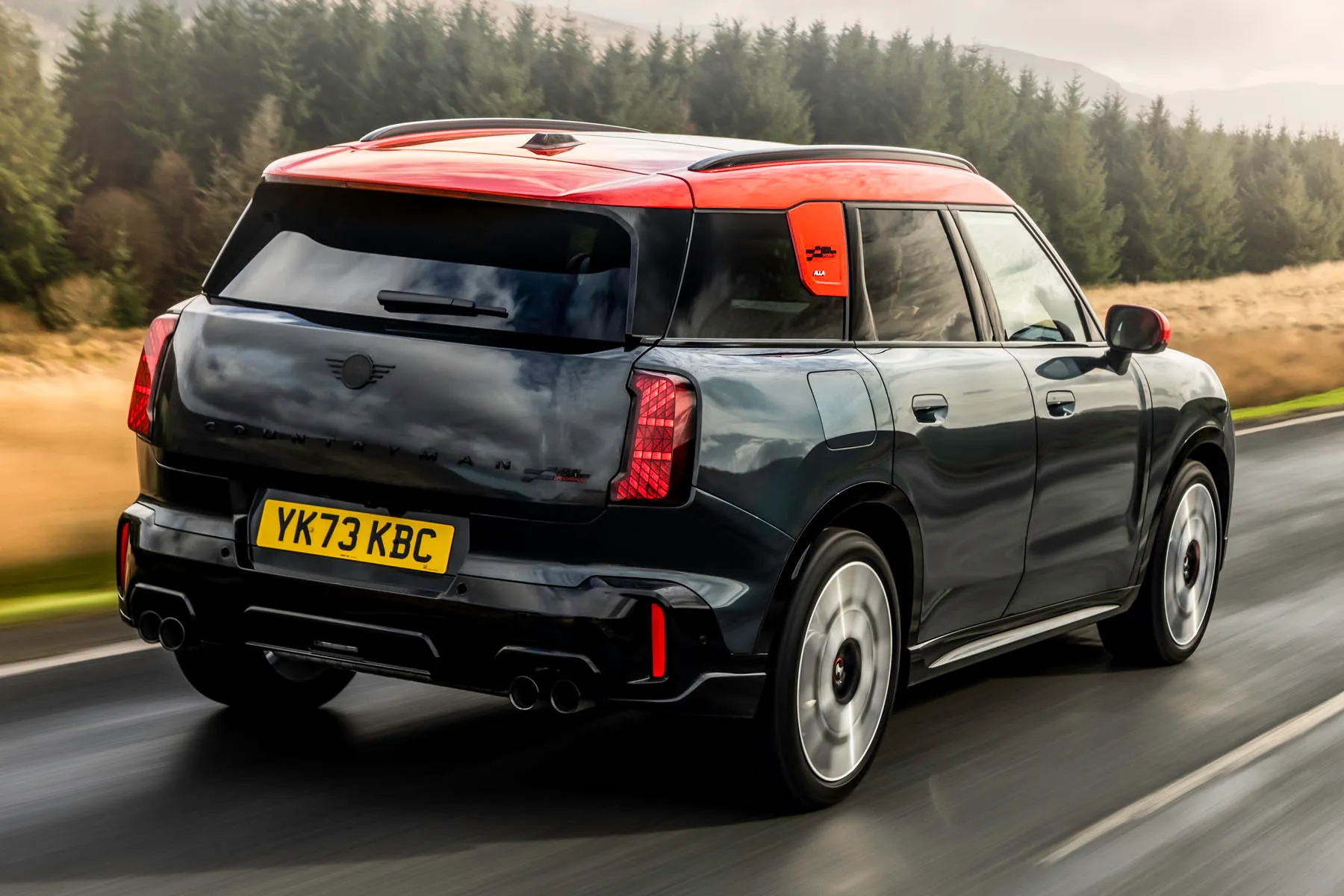
As is usually the case with BMW Group products, the Countryman’s behaviour in this area depends greatly on how you spec it. Specify the C or S models in either the Classic or Exclusive trim levels, and you’ll get the standard passive suspension setup. On this arrangement, the ride is decidedly firm. It can feel rather jittery on surfaces with high-frequency ripples and grainy, patched-up finishes, and you’ll also feel a bit of a thump over larger potholes. The car stops short of being uncomfortable most of the time, but it’s also true that many rivals are more cosseting.
Of course, you can’t talk about any MINI product without talking about ‘go-kart-like handling’, especially when MINI has doubled down on this part of the brand’s traditional appeal by naming the sportiest of its driving modes the ‘Go-kart mode’.
In truth, the go-kart comparison isn’t as convincing in the Countryman as it is with other MINI models (and never has been), but it’s not entirely without basis. The steering is super-quick, both to respond and to turn, but it doesn’t feel twitchy. There’s plenty of grip and traction, too, even in the front-wheel-drive C version.
The body feels reasonably well controlled through shallower bends, too, but in tighter ones, the MINI's height causes the body to lean over more, while in swift switchbacks, the resulting weight transfer can have a slightly unsettling effect. All in all, the car generally feels pointy and direct, but without feeling all that nimble or agile.
However, specify your Countryman in Sport trim, or choose the JCW, which only comes in Sport trim, and your suspension is upgraded to an adaptive setup. This has a beneficial effect on how your Countryman drives, but perhaps not in the way you might expect.
Like with many such systems, the adaptive dampers become firmer when you select the sportiest driving mode, although in truth, you’ll barely notice, even if you’re really concentrating, because the difference is absolutely minuscule. However, the suspension is also adaptive in the sense that it constantly alters its behaviour according to road conditions and driving behaviour in order to maximise the balance between ride and handling. And it’s this bit that’s really effective: it makes the JCW feel a teeny bit more tied down and sharper under more severe cornering loads, but more importantly, it also improves the ride comfort by quite a bit. It’s still a firm-but-fair experience, but is appreciably more forgiving.
What engines and gearboxes are available in the MINI Countryman?
The MINI Countryman is available in a couple of all-electric forms, but we’ve reviewed those independently, so here, we’ll concentrate solely on the combustion-engined versions of the car.
The range kicks off with the Countryman C, and this uses a 1.5-litre three-cylinder petrol engine - aided by a small mild-hybrid electric motor - to deliver 170PS to the front wheels through a dual-clutch automatic gearbox. On paper, the 0-62mph sprint is dispatched in 8.3 seconds, and in reality, the level of performance provided will be entirely adequate for most drivers.
There’s enough low-down punch to allow you to build up a decent amount of speed without working the engine to its limits, which is just as well because it does get rather shouty when you do, and that noise is accompanied by quite a few vibrations through the steering wheel and pedals. The gearbox in the C could perhaps be a little bit quicker and smoother in the way it goes about its business, but it’s unobtrusive enough most of the time.
Sitting in the middle of the range is the Countryman S, which uses a 2.0-litre four-cylinder petrol engine and the same mild hybrid system as the C to deliver a total of 218PS, this time to all four wheels. The 0-62mph time is given by BMW at 7.1 seconds, but because we haven’t tried this variant yet, we can't tell you what it feels like.
The Countryman range is topped by the John Cooper Works variant, or JCW for short. There’s no mild-hybrid trickery here, just a 2.0-litre, four-cylinder petrol engine that dishes out 300PS, again to all four wheels. The 0-62mph dash is trimmed to 5.4 seconds and a top speed of 155mph can be theoretically reached. And sure enough, the car feels decidedly rapid, and the power delivery is muscular and eager at all times. Having said all that, though, it’s also true that the JCW doesn’t quite feel as ballistically fast as the power output would suggest.
Refinement and noise levels
Like we said earlier, the three-cylinder petrol engine in the C version can sound a bit thrummy and coarse when you really work it, but there’s enough urge low down in the rev range that you don’t often have to, so it stays subdued most of the time.
We haven’t tried the 2.0-litre turbocharged petrol engine in the mid-range S model yet, so we can’t tell you what that’s like for refinement, but the more powerful one in the JCW version is good, staying quiet and peaceful when you want it to, and sounding nice and throaty when you’re in a more playful mood. You don’t get the pops and bangs from the exhaust that you do in JCW models of the past, but in a family SUV, that’s probably a good thing.
Wind noise is pretty well isolated for such a tall car, but whichever model you pick, you will be subjected to a fair amount of road noise, even at moderate speeds.
There’s also the effect of the ‘MINI Sounds’ to consider. These are a series of different sound effects and jingles that are piped into the cabin through the stereo speakers according to which of the eight ‘Experience’ modes you select (the modes also vary what you see on the central screen in terms of colour, content and layout, and also alter the colour and intensity of the ambient cabin lighting). For some people, this will be an appealing augmentation to the driving experience of their car, while for others, it’ll be a step too far on the gimmick scale. If you sit in the latter camp, it can be switched off.
Safety equipment: How safe is the MINI Countryman?
The latest MINI Countryman comes with a very decent amount of safety kit as standard. This includes autonomous emergency braking, lane-keep assist, blind spot detection, rear collision prevention, speed limit recognition and assist, adaptive cruise control, and emergency call.
Unsurprisingly, the MINI Countryman scored a full five star when subjected to Euro NCAP crash tests.
MPG and fuel costs: What does a MINI Countryman cost to run?
"The MINI Countryman is far from cheap to buy, either as a new car or a used car. Official fuel economy figures don’t look particularly impressive, either."
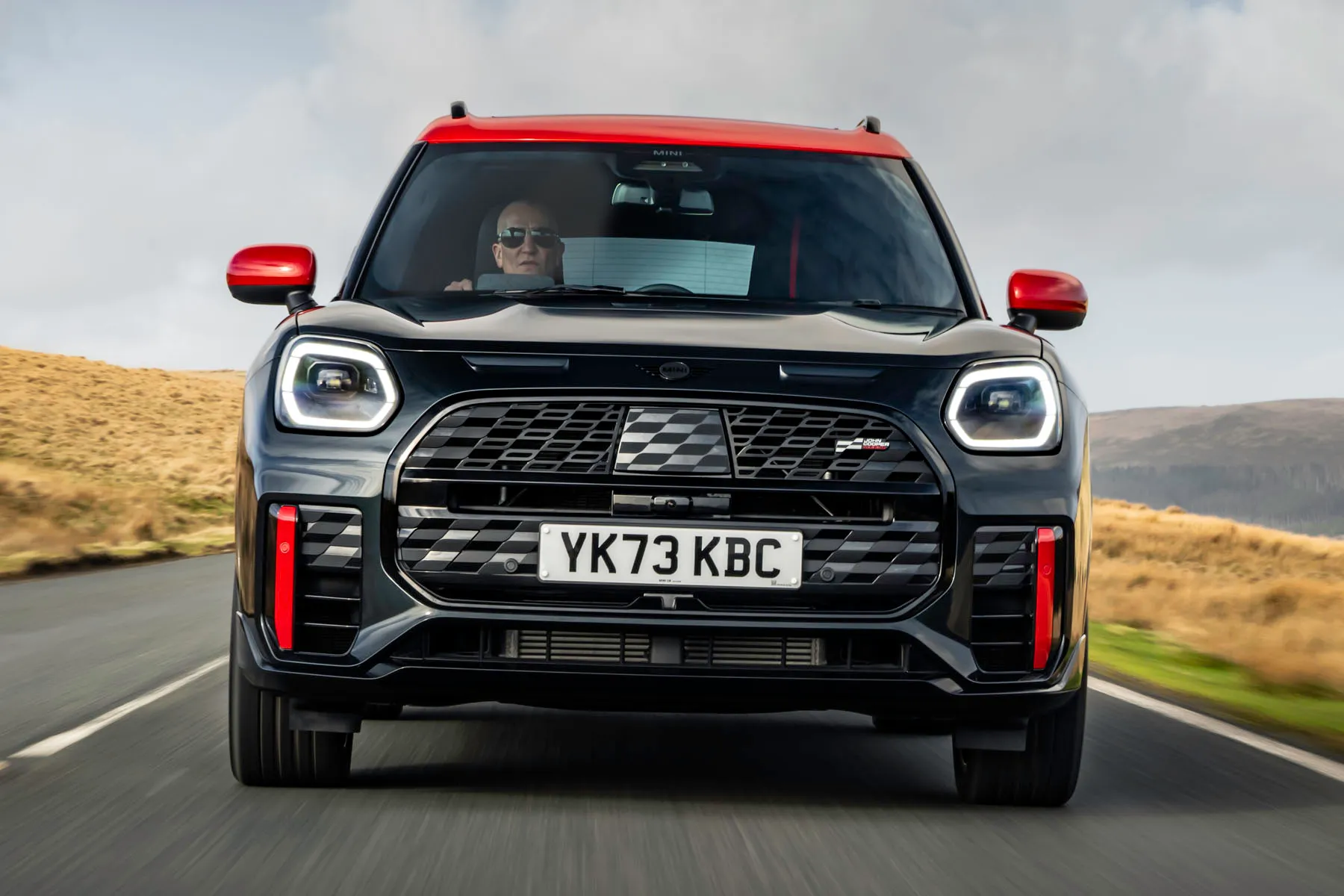
There’s quite a spread throughout the MINI Countryman range when it comes to fuel consumption. The C does best, managing a combined WLTP fuel figure of up to 47.9mpg, while for the more powerful S, that drops to 42.8mpg. These figures are no great shakes, especially when compared with the figures of rivals, and that’s doubly surprising given that both these versions have 48-volt mild hybrid technology. Go for the JCW, meanwhile, and you’ll be down to an official average of around 36.2mpg.
MINI Countryman reliability and warranty
The latest MINI Countryman is built using all-new technology, so there hasn’t been enough time to ascertain whether any regular reliability issues have come to light. It also means that the car bears pretty much no mechanical resemblance to any MINI product that has gone before it, so assessing the reliability of those models will only be of limited use. Perhaps that’s just as well, because MINI placed in a rather mediocre 20th out of 33 carmakers in the latest HonestJohn.co.uk Satisfaction Index for owner satisfaction and the same for reliability.
MINI Countryman insurance groups and costs
The Countryman C sits in insurance groups 19 or 20 depending on what trim level you choose, while if you upgrade to the S, it’ll be in groups 24 or 25. Buyers of the JCW will pay most due to a group 30 classification. Premiums won’t be massively cheap on any version, then, but they shouldn’t be too painful on most, and given its level of power, it’s perhaps a little surprising that the JCW’s grouping isn’t a little higher.
VED car tax: What is the annual road tax on a MINI Countryman?
The petrol-engined versions of the MINI Countryman are subject to the same flat-rate of VED tax payments as every other petrol and diesel car currently on the market. As such, you'll pay £195 per annum when it reaches its first birthday.
That’s not the full story, though, because cars that cost more than £40,000 when brand new, including any optional extras added, are also subject to an additional £425 surcharge on top of that for a period of five years, between years two and six of the car’s life. The JCW costs more than the threshold, so all of those will be liable, while several versions of the S get quite close to that threshold on price, so adding one of the various options or packs available could well take it over and land you with the extra hit. It’s worth doing an online check with the registration of any used example you’re considering just to make sure you know exactly what you’re looking at.
As for road tax when you take delivery of a new MINI Countryman, this will be bundled up in the overall price. However, be aware that a C model will cost £540 and the S between £540 and £1360 depending on exact spec. As for the JCW, it comes in at a much sterner £2190.
MINI Countryman price
"The MINI Countryman certainly isn’t cheap, but prices don’t feel too bonkers considering the amount of space and equipment you’re getting for your money."
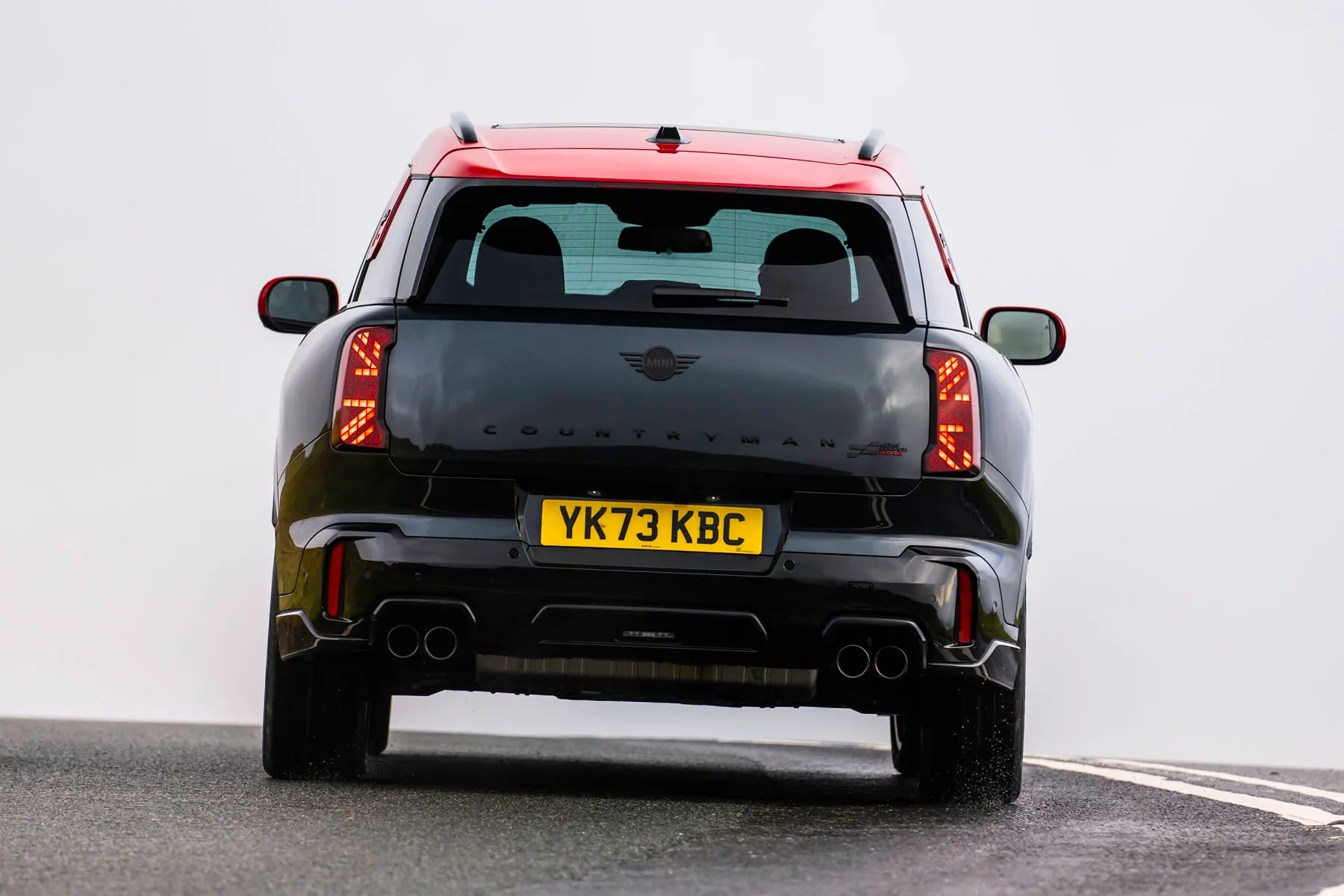
If you’re buying brand new, the Countryman range starts at around £30,000 for the entry-level C variant, rising to around £35,000 for the more powerful S version and rising to around £43,000 for the JCW. If you go electric, you’ll be looking at around £42,000 for the E and £47,000 for the SE.
It’s a bit early for pre-owned versions to have hit the used car market in any significant number, but it’s always worth looking for cars that have been pre-registered by dealers in order to hit sales targets, as snaffling up one of these can get you an as-new car with delivery mileage for a handy four-figure saving. A quick look revealed you could save around £1400 by opting for a pre-registered Countryman, which is a handy saving on the C model.
Trim levels and standard equipment
The basic equipment list on the Countryman includes alloy wheels, ambient interior lighting, dual-zone climate control, roof rails, parking sensors, a reversing camera, a powered tailgate, a heated steering wheel, and rain-sensing wipers. Standard spec also includes LED lighting all round, and you can choose between three different lighting signatures and animations through the touchscreen. That’s on top of all the infotainment and safety equipment we’ve already talked about.
On top of that, you choose between three trim levels, named Classic, Exclusive and Sport. These are less about providing any additional luxury kit, and more about the exterior and interior design of your car, with varying combinations of colours, patterns and finishes. It is, however, worth noting that Sport trim does bring the very effective adaptive suspension.
As ever with a BMW Group car, there’s a wide variety of optional extras that can be added, many of them in packs, but be sensible with these as they can get the price of your car soaring skywards alarmingly quickly.
Ask the heycar experts: common questions
Is the MINI Countryman a good car?
Is the MINI Countryman an SUV?
How much does the MINI Countryman cost?
Get our latest advice, news and offers
Keep me updated by email with the latest advice, news and offers from heycar.
By submitting you agree to our privacy policy
